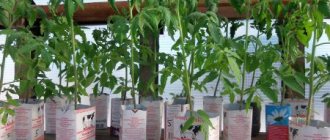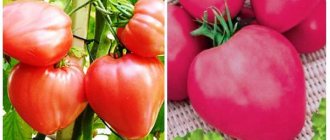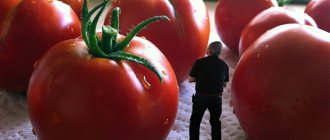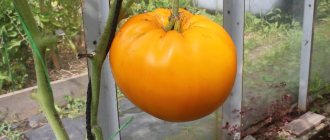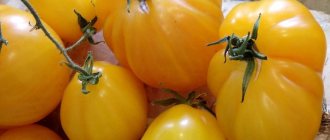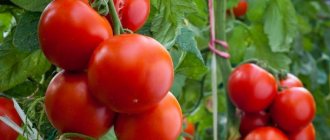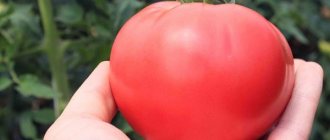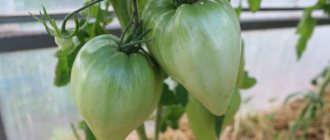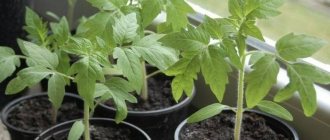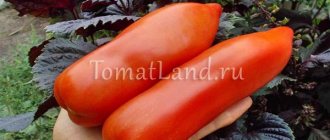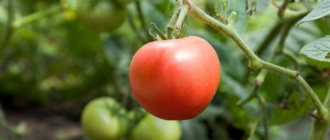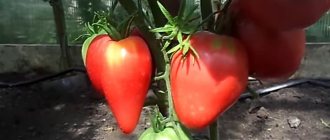The Canadian giant tomato is not very common in Russian gardens, but is familiar to many gardeners who are fond of tomatoes. Its seeds are distributed by several collectors at once. The variety is distinguished by large, tasty fruits that can be eaten by the whole family or sold.
| Height | Landing location | Ripening time | Fruit color | Fruit size | Origin | Fruit shape |
| Tall | Open ground | Mid-season | Reds | Large | Variety | Flat-round |
Description and characteristics of the variety
The originator of the Canadian giant tomato is unknown, and the variety is also not included in the State Register.
It has tall indeterminate bushes, the minimum height of which is 150-180 cm, but can grow up to 2 meters. Potato type leaves. The fruits ripen in the middle period.
The variety grows well in open ground. It should be planted in a greenhouse only in cold regions.
The weight of tomatoes is from 300-500 g to 800 g (with proper pinching and removal of excess ovaries). These are beefsteak tomatoes, with meaty flesh. The color is red. There are few seeds and juice inside, the pulp is tender, sweet, tasty and aromatic. Tomatoes are used for salads, making pastas and various dishes.
Real reviews from gardeners
There is no consensus among amateurs and professionals about the name of the tomato. Most likely, it was given by domestic gardeners. The variety bears fruit for quite a long time. In a temperate climate, in an open garden bed, summer resident Alisa collected an unfriendly harvest until mid-September. In her experience, tomatoes can be picked brown, in a state of technical ripeness. They will be ripe, but will lose their taste.
The woman compares this tomato with a similar variety, Orange Russian 117. Canada wins in the taste and tenderness of the pulp, its counterpart - in the shelf life of the harvested crop. Ekaterina from Volgograd noted the best yield of Orange Russian. She grew the compared varieties at the same time.
Inna from Sverdlovsk region. in his review he notes the capriciousness of the variety to growing conditions. Due to the weather and nuances of care, the ripening time can be significantly extended. The Canadian heritage has not yet been widely tested by Russian summer residents. It has many advantages, but there are also negative qualities.
Landing
Tomato seedlings are planted at the end of March or 55-60 days before transplanting to the garden bed. To obtain healthy seedlings, prepare nutritious soil from soil from the garden with the addition of humus, peat and sand, as well as a slightly smaller amount of wood ash. You can add a little superphosphate so as not to feed the seedlings in the future. The resulting soil must be calcined in the oven or disinfected with potassium permanganate.
Rules for growing seedlings:
- Disinfection of seeds (they are placed for an hour in a one percent solution of potassium permanganate, then washed).
- Sunny location.
- Before germination of plantings, it is warm (+25 or more), after germination, the temperature is no higher than +22 degrees, and in the first days of the bushes’ life it can be lower.
When 2 leaves appear, the bushes dive into the peat pots. 2-3 plants are placed in the garden bed.
Features of growing the variety
Pre-sowing treatment for tomatoes is very important. Seeds need to be tested for germination in salt water, and any that float should be removed. Before planting, 3-4 days before planting, the seed can be soaked in a manganese solution for an hour, then rinsed and dried. And a day before sowing, soak the seeds in aloe juice for 2-3 hours - this will stimulate the immune system and speed up germination. Sowing begins in late February and early March according to the lunar calendar.
It is best to mix soil purchased and from the garden, since the variety is demanding in terms of composition. Proportions of 1/1 are suitable, but you definitely need to etch the soil with boiling water and manganese and then dry it. Plant seeds in a common tray or individual cups, which is more convenient under film. During germination, the temperature is needed at 26-28 degrees, after 23-25 degrees. In the phase of 3-4 leaves, seedlings are fed with urea.
Transfer to the greenhouse and greenhouse is carried out from mid-May, when it became warm even at night - from +15 degrees. The soil is prepared and the entire greenhouse is treated with antiseptics. We have already talked about crop rotation. Humus and ash are added to the soil, dug up, and then a complex preparation is added to each hole. Be sure to pour boiling water on it. 2-3 holes are dug per meter. Since the variety is demanding on moisture, it is better to mulch the beds.
To get the maximum yield, all the shoots are planted, but one is left in the upper fork - this is the second stem. Every 10-14 days, additional feeding is carried out - the manure is diluted 1/10, the next time they are fed with complexes - “Superphosphate”, “Universal”. This is how they alternate throughout the growing season. To prevent diseases, they are sprayed once a week with a weak solution of manganese; to stimulate flowering, “Ovary”; insects are driven with infusions of spices.
Growing and care
Water tomatoes only with warm water, being careful not to wet the stem and leaves, during periods when the bushes are not exposed to direct sunlight. Moisturize as needed, but regularly.
Irregular watering leads to cracking of fruits, especially in large-fruited varieties.
Feed 3-5 times. There are three basic feedings:
- on the tenth day after rooting of seedlings;
- at the beginning of budding and flowering;
- at the beginning of fruiting.
Young bushes need nitrogen more than other elements, while older bushes need potassium and phosphorus more.
Plants are tied to supports and formed into 1-3 stems. Excess ovaries are removed to obtain large tomatoes.
Resistance to diseases and pests
As you already understand, the variety does not have absolute resistance. Therefore, you will need to carefully monitor your plantings, carry out pre-sowing treatment of the greenhouse and seeds to eliminate risks. Agricultural technology is very important; it is also worth observing crop rotation for the “Red Giant” variety, not planting it after potatoes, carrots, cucumbers, and peppers. Moreover, this cannot be done if before this the plants were sick in this place.
Manufacturers do not say anything about insects, which means they can cause harm, especially since the variety begins to ripen during a period of increased parasite activity. To prevent them from causing harm, it is important to prepare the site, plant competently planted neighbors, and carry out prevention.
To ensure your plantings remain intact, you can plant garlic, onions, herbs around the greenhouse, and scatter ash. Insects do not tolerate odorous substances.
Tomato Zimarevsky giant: reviews, photos, yield
We are accustomed to the fact that a tomato bush usually reaches a height of eighty, ninety, one hundred centimeters. Fruits - 150 grams each. Sometimes more, sometimes less. The average yield per bush is 1.5-2 kilograms.
But the usual in this case did not satisfy me. I tried both those varieties and these... They grow and bear fruit. It's not the same.
Once I learned about the amateur gardener Alexander Vasilyevich Tsaregradsky. He lives in the Ivanovo region. Experimenting. His most interesting work is a tomato, to which he gave the name “Giant”. The height of the bush is up to two meters. The fruits are large - 600-800 grams. The yield per bush is from 17 to 20 kilograms.
But I’m not retelling an article about Alexander Vasilyevich, I’m reporting on those specimens of the Giant that have taken root in my garden.
The Giant liked the local land and the southern sun. Now in our area this variety is not a curiosity. Many hobbyists breed it. And they all liked it.
The Giant fruits have less acid and more sugar than our other old-timers. They are less watery and have almost no seeds.
The Giant is good for everyone. One thing is bad: the fruits are unsuitable for transportation - they are too large.
There is another tomato growing in the garden. Brazilian. Its bush is even more impressive than the Giant’s bush—it rises to a height of up to three meters. And the harvest, if you take the shaft, is more substantial: it is quite possible to remove 25 kilograms from a bush. The fruits are red, glossy, oval, very tasty, without tomato acid. And the fruits themselves are small: 100-125 grams.
Read also: Plants of a corner of nature in kindergarten
The Brazilian tomato has another significant advantage: its fruits are very well preserved. Picked green in late autumn, they ripen indoors and last until January.
Along the way, I’ll give you some tips: it’s best to sow Brazilian tomatoes in early February. Seedlings should be transplanted into the ground at the end of April. Before planting, nitrogen-potassium fertilizers are applied. A post is strengthened near each bush, to which the plant is tied as it grows. It’s good to plant garlic nearby: it repels pests.
In addition to Brazilian ones, there are also Mexican tomatoes. They are easy to distinguish: they grow in small cases. Such lucky ones are born in shirts...
This plant is not striking either in the size of the bush or in the size of the fruit. The bush is small, and the fruits weigh about fifty grams on average.
The growing season for Mexican tomatoes is 80 days. Compare: ours have 112. Thirty-two days difference. There is hardly any need to prove how beneficial this is. Well, what do they taste like? Very, very mediocre.
What then attracts small Mexican tomatoes? Gelling agent - pectin. Add twenty percent Mexican tomatoes to ordinary jam and you will get a mass so thick that you can cut it with a knife. Essentially, you will already have marmalade.
Another variety of tomatoes is currant. The fruits are no larger than an ordinary cherry. They grow like currants, that is, on one branch there are 9 pieces on one side and the other. Taste like regular tomatoes.
This tiny, toy vegetable is very popular with children.
The best varieties of tomatoes
When there are two clusters of fruit on the bush, and the bush has grown to a meter mark, I carry out chasing: with pruning shears I trim the entire row to a “comb” - Then the roots already work only for the fruits, and they turn out excellent! For the sake of quality, you have to sacrifice quantity, but at least the tomatoes are for exhibition!
I have one more technique, I call it a vaccination. Although, in principle, this is the merging of two bushes with the subsequent pinching of one of the two stems.
I take two bushes of seedlings (at any age, when I have free time), grown in cups. In the upper part of the stem I find the most flexible place and with a new blade I make a flat (small cut) - 25-30 mm, cutting off the bark and capturing a little of the pulp of the stem. On the second plant there is exactly the same bald spot, the main thing is that they coincide when connected. I connect the flats and tie them, like a bandage, with a strip of plastic film 8-10 mm wide. A week later I pinch out the weaker bush. It turns out one plant on two roots.
After a month, the film can be removed, or you can bandage it again, but weakly - just to be on the safe side.”
I plant tomatoes in two waves: the first ones are already leaving, and the second ones are starting to ripen. I also plant two seedlings in a hole: if one destroys the mole cricket, the second will survive, and it’s also more convenient to graft them. I plant at a distance of no more than 10 cm. In those holes where there are two bushes left, I make sure to connect them, thereby doubling the Vitality of the bush. The principle of grafting is the same as for seedlings in pots.
This method is good because, as I already said, the fruits are excellent, and most importantly, you can save space, which is especially important for summer residents, Pavel SLIPICH, Kherson
Advantages and disadvantages
- large fruits, juicy, fleshy;
- Widely used in cooking and excellent taste;
- good yield;
- relative resistance to disease.
- demanding of weather conditions;
- you need to shape the bushes, tie them up, and pin them;
- the fruits are not preserved whole;
- there is no absolute resistance to diseases and insects;
- demanding on soil composition and care.
Of course, the “Red Giant” tomato, according to its characteristics and description of the variety, has disadvantages, but it also has significant advantages. If you like to cultivate in the garden beds and make a lot of preparations for the winter, then this is a very good variety for you. If you are a beginner, then take a responsible approach to learning all the nuances of agricultural technology.
Video: Caring for tomatoes. First important steps
I'm not a tomato fan. Every year I grow a minimum of varieties: early, late and one for testing. And that’s hard! And if there are a dozen varieties, this is hellish work, and I can only admire and... sympathize with such people.
For example, the Red Giant variety never leaves my garden. I love it for its high taste and appearance, and also because the price for it is always high on the market. This variety makes excellent salads and excellent juice.
In order for the tomato to have a marketable appearance and be large, I’m wise and I’ll do it slowly.
